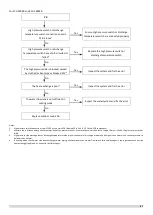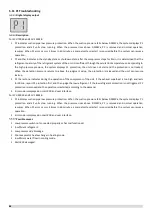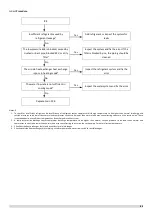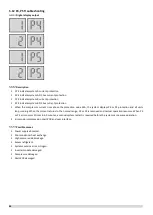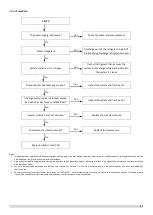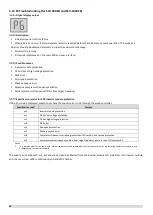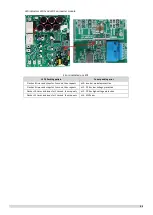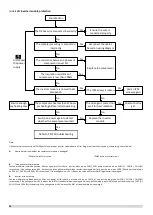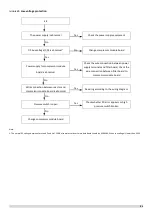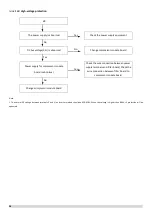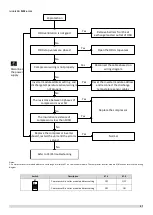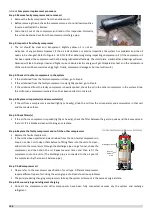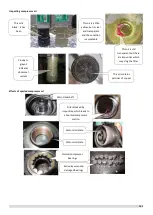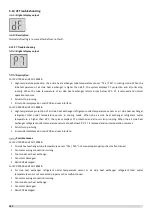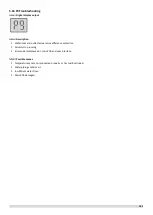
100
Compressor replacement procedure
Step 1: Remove faulty compressor and remove oil
Remove the faulty compressor from the outdoor unit.
Before removing the oil, shake the compressor so as to not allow impurities
to remain settled at the bottom.
Drain the oil out of the compressor and retain it for inspection. Normally
the oil can be drained out from the compressor discharge pipe.
Step 2: Inspect oil from faulty compressor
The oil should be clear and transparent. Slightly yellow oil is not an
indication of any problems. However, if the oil is dark, black or contains impurities, the system has problems and the oil
needs to be changed. Refer to Figure 4-4.20 for further details regarding inspecting compressor oil. (If the compressor oil
has been spoiled, the compressor will not be being lubricated effectively. The scroll plate, crankshaft and bearings will wear.
Abrasion will lead to a larger load and higher current. More electric energy will get dissipated as heat and the temperature
of the motor will become increasingly high. Finally, compressor damage or burnout will result.)
Step 3: Check oil in other compressors in the system
If the oil drained from the faulty compressor is clean, go to Step 6.
If the oil drained from the faulty compressor is only lightly spoiled, go to Step 4.
If the oil drained from the faulty compressor is heavily spoiled, check the oil in the other compressors in the system. Drain
the oil from any compressors where the oil has been spoiled. Go to Step 4.
Step 4: Replace oil separator(s) and accumulator(s)
If the oil from a compressor is spoiled (lightly or heavily), drain the oil from the oil separator and accumulator in that unit
and then replace them.
Step 5: Check filters(s)
If the oil from a compressor is spoiled (lightly or heavily), check the filter between the gas stop valve and the 4-way valve in
that unit. If it is blocked, clean with nitrogen or replace.
Step 6: Replace the faulty compressor and re-fit the other compressors
Replace the faulty compressor.
If the oil had been spoiled and was drained from the non-faulty compressors in
Step 3, use clean oil to clean them before re-fitting them into the units. To clean,
add oil into the compressor through the discharge pipe using a funnel, shake the
compressor, and then drain the oil. Repeat several times and then re-fit the
compressors into the units. (The discharge pipe is connected to the oil pool of
the compressor by the inner oil balance pipe.)
Step 7: Add compressor oil
Please refer to the compressor specification for oil type. Different compressors
require different types of oil. Using the wrong type of oil leads to various problems.
The principle during changing compressor is to keep the system oil amount is the same as original state.
Step 8: Vacuum drying and refrigerant charging
Once all the compressors and other components have been fully connected, vacuum dry the system and recharge
refrigerant.
Discharge pipe
Inner oil
balance
pipe
Содержание SCV-1400EB
Страница 2: ......
Страница 4: ...2...
Страница 8: ...6...
Страница 26: ...24...
Страница 46: ...44 1 Electric Control Box Layout For SCV 750EB For SCV 1400EB...
Страница 61: ...59 3 Wiring diagram 3 1 Single unit For SCV 750EB and SCV 1400EB...
Страница 62: ...60 For SCV 900EB...
Страница 63: ...61 For SCV 1800EB...
Страница 78: ...76 5 5 E3 E4 E5 E7 Eb Ed EE EF EP EU Fb Fd Troubleshooting Digital display output...
Страница 159: ......
Страница 160: ...0 1 234 56 0 7 8 234 0 9 1 7 1 0 6 16 3 5 9 4 260 88 4 260 88 08 88 688 0 4 08 4 6 4A8 60 B...


